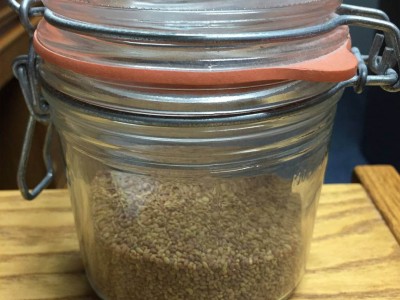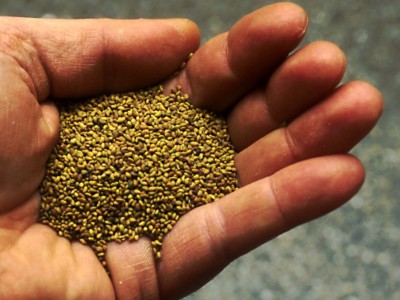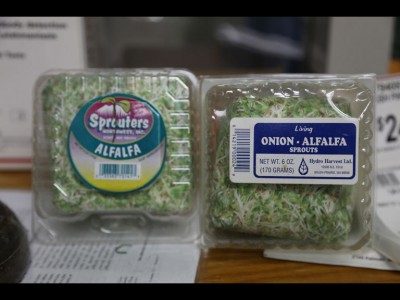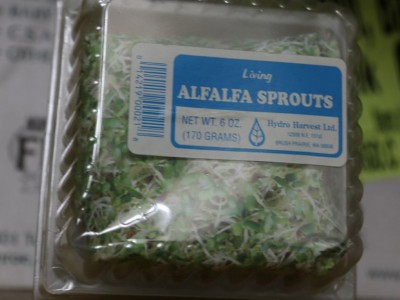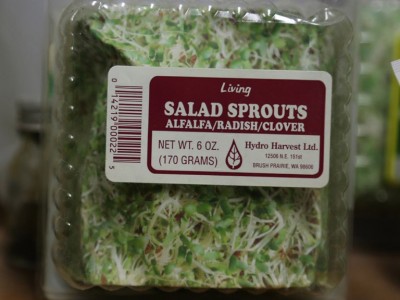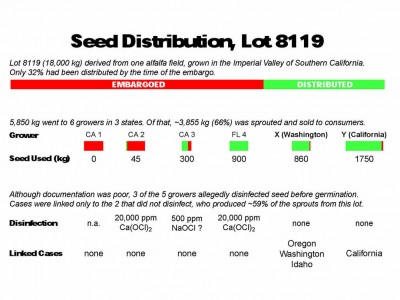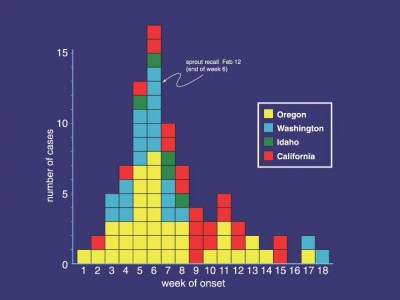| Outbreak: Hydro-Harvest alfalfa sprouts | |
|---|---|
| Product: Alfalfa sprouts | Investigation Start Date: 02/01/1999 |
| Location: Multi-State: OR, WA, ID. | Etiology: Salmonella Mbandaka |
| Earliest known case onset date: 01/09/1999 | Latest case onset date: 06/12/1999 |
| Confirmed / Presumptive Case Counts: 43 / 0 | Positive Samples (Food / Environmental / Water) 12 / 0 / 0 |
The increasing popularity of sprouts as health foods was sharply followed by the epidemiologic discovery that sprouts are prone to transmitting foodborne pathogens like Salmonella. This was the largest “sproutbreak” of foodborne salmonellosis in Oregon since the multistate and multinational outbreak of Salmonella Newport infection in 1996, in which alfalfa sprouts were also implicated as the vehicle of transmission.
- • Outbreak Publication: Emerg Infect Dis. 2003 Apr; 9: 474-9
- • Investigation summary hand out (PDF)
- • “CD Summary” Newsletter (PDF)
- • Outbreak Questionnaire (PDF)
Background
Since 1995, sprout products (alfalfa, clover, radish, mung bean) have become recognized as common vehicles for enteric pathogens including Salmonella, Escherichia coli O157, and Listeria. Outbreaks have been recognized repeatedly in Europe (notably Scandinavia), North America, and Japan. Most of these outbreaks have been traced to the use of contaminated seed, in which pathogens proliferate during germination. Seed lots are often quite large (≥18,000 kg) and may be distributed to numerous growers in widely dispersed locations. Outbreaks often manifest as cases scattered across several states or countries, and can persist for months, reflecting the stability of the pathogen on dried seeds.
The only completely reliable way to prevent sprout-associated illness is abstinence. In the United States, several state health departments, the FDA, and other agencies have issued statements discouraging raw sprout consumption. Because of the increased risk for severe infection with at least some sprout-associated pathogens (notably Salmonella and Listeria), these warnings are often targeted at immunocompromised individuals. Most persons who become ill in outbreaks are immunocompetent, however.
Many people enjoy eating sprouts, and many people make a living growing, processing, and distributing these products. In consequence, food scientists and members of the sprout industry have investigated procedures to improve the safety of sprouts. These efforts have concentrated on chemical disinfection of seeds immediately prior to germination.
Laboratory studies suggest that treatments with sodium hypochlorite or calcium hypochlorite can reduce Salmonella loads on artificially inoculated seeds to undetectable levels. Calcium hypochlorite (at 20,000 ppm) has been strongly recommended, because higher disinfectant levels are achievable without unacceptable reductions in germination rates.
Some outbreaks provide natural experiments that shed light on the effectiveness of seed disinfection. Oregon Public Health Division epidemiologists investigated one such outbreak in early 1999.
Methods
By law, all Salmonella isolates identified by Oregon laboratories are forwarded to the Public Health Laboratory for serotyping. Similar law or custom obtain in Washington, California, and Idaho. Salmonella Mbandaka is uncommon in Oregon (1988–98 mean, 1.5 cases/year). When 3 Mbandaka isolates were identified within a week in January 1999, it was not difficult to surmise that a common-source outbreak was occurring. Surrounding states and CDC were notified immediately. Initially, reported cases were confined to Oregon. (CONTINUED BELOW ↵)
Preliminary interviews were conducted with cases or household informants by local health department nurses using standardized case investigation forms. Sprouts—a perennial suspect in geographically dispersed outbreaks of salmonellosis—quickly became a focus of the investigation.
Investigators compared exposure histories of the first 10 Oregon cases reported with those of age- and phone prefix-matched controls. We traced sprouts consumed by cases to their origins.
Information about later cases was collected by public health agencies in Washington, Idaho, California, and Oregon. Environmental investigations at produce retailers and wholesalers and with sprout growers and seed distributors were conducted by the Oregon and Washington Departments of Agriculture, the California Department of Health and Human Services, and the FDA. Sprouts and seed samples were collected and cultured for Salmonella.
Results
Initial suspicions that commercially distributed alfalfa sprouts were the source (based on demographics, case distribution, and preliminary food histories) were corroborated by case-control study results. Nine of the first 10 cases recalled alfalfa sprout consumption vs. 0/20 controls (p=0.002). Among cases who had consumed sprouts, 8/9 reported definite (N=5) or possible (N=3) consumption of Hydro-Harvest sprouts (see Product Traceback figure). No other plausible source was identified.
On February 12, press releases were issued announcing a voluntary recall of all Hydro-Harvest sprouts. S. Mbandaka was later cultured from alfalfa sprouts and ungerminated seed collected at the Hydro-Harvest facility. Outbreak-associated cases were eventually identified in four states (see Epidemic Curve): Oregon (N= 40), California (N= 21), Washington (N= 19), and Idaho (N= 5).
A common outbreak pattern was identified by molecular typing (PFGE and micro-restriction fingerprinting). This pattern differed from those of “sporadic” isolates obtained before the outbreak, which were heterogeneous.
The implicated seed came from an 18,000-kg lot milled from alfalfa grown in Southern California. By the embargo date, seed from that lot had been distributed to 4 growers in California, 1 in Florida and Hydro-Harvest in Washington (see Seed Distribution figure); one grower had not started to use it. Cases were eventually linked to only 2 of the 5 growers that had sold sprouts from this lot, however: Hydro-Harvest (OR, WA, ID cases) and brand Y in San Diego (CA). Although documentation was incomplete, the 3 sprouters (CONTINUED BELOW ↵)
that were not linked to any cases (and who used 41% of the seed) allegedly disinfected with 20,000 ppm calcium hypochlorite or 500 ppm sodium hypochlorite.
Conclusions
This outbreak provided an imperfect natural experiment to assess the efficacy of alfalfa seed disinfection. The observation that—cases were attributable only to the growers who did not disinfect seed–is consistent with, though not proof of, the hypothesis that seed disinfection can reduce the risk of salmonellosis for sprout consumers.
Seed disinfection procedures could not be verified at any site. No sites, including those who allegedly used the FDA-recommended 20,000 ppm calcium hypochlorite soak, maintained any sort of production log or similar, contemporaneous documentation of disinfection practices. The germination procedures, undertaken by Hydro-Harvest and grower Y, could not be independently verified.
Whether contamination within seed lot 8119 was uniform could not be assessed, but, S. Mbandaka was recovered from almost every sample tested (both from ready-to-eat sprouts and from seed collected Hydro-Harvest, grower Y, and the originating warehouse).
The number of reported cases reflects to some extent publicity about the outbreaks, which differed from state to state. Most importantly, data from other outbreak investigations indicate that even the preferred 20,000 ppm calcium hypochlorite disinfection can be inadequate under at least some circumstances. Seed disinfection may be better than nothing, but it is unclear how much.
Recommendations
Sprout growers should routinely document seed disinfection methods, and outbreak investigators should carefully review and report these practices. As these data accumulate, we will get a better sense of how effective seed disinfection is.
Sprouts continue to pose a risk for all consumers. Despite episodic publicity, many consumers remain unaware of this risk. Public health advisors should consider ways to increase awareness of this hazard, particularly among high-risk individuals.

